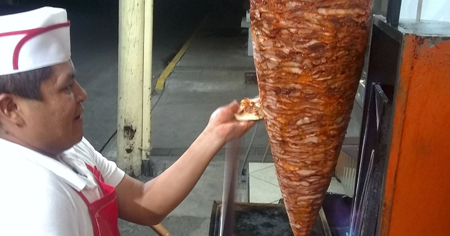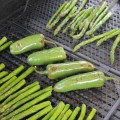By José C. Marmolejo
The moment humans connected fire with food must have been magic. To me still is. It could be looking at the mesmerizing dance of flames under a clay griddle, or the sizzling sound of a cold steak hitting a hot grill, or the smell of burning wood and animal fat together. That’s magic to me…
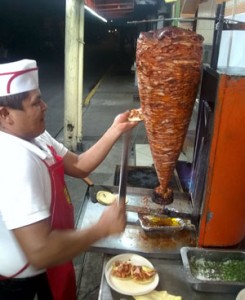
Tacos al pastor: a common sight on the streets in Mexico
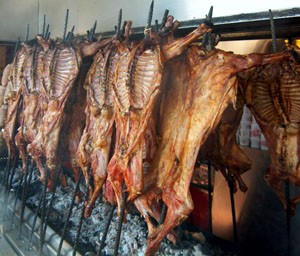
This conclusion aside, I submit that the next technique developed was “al pastor”, literally “shepherd style”. It consists of skewering the meat—hunt or domesticated, parts or the whole animal—and placing it on the ground a bit inclined towards the fire. Contrary to pit cooking, the food was visible while it was being cooked, and most likely generated a discussion among the participants about when the meat was ready to eat. An argument about how to do it? Probably yes. It should be noted that no ashes and dirt were involved in this technique, which proved better than burying the food without protection.
What is the status of cooking on an open fire today? Alive and well, including the discussions around the fire about how to do it. When it comes to cook on an open fire in Mexico, there is always someone—usually the last one to arrive to the function—that knows better how to tend the fire and how to cook the meat. Discussions about it are the norm. The most common phrase heard is “move over, you don’t know how to do this.” I’ve come to think that most gentlemen don’t know how to do it anyway. But discussion is part of this beautiful ritual thoroughly sprinkled with cerveza and Tequila. And while the gentlemen compete on “fire arts” outside, there is a juicy conversation going on in the kitchen by the ladies. I assume it is about the salad or the dressing or some other interesting subject like the absent girlfriend…
In Monterrey, Mexico, Cabrito al Pastor is a signature city dish. Always crowded, restaurants that offer this delicacy prepare it before your eyes. The fire is set in a trench-like masonry construction at waist height that supports the steel rods inclined towards the coals and hold the open carcasses of what the day before was a happy baby goat. One can only imagine that the only thing that has changed in thousands of years is the height of the fire and the material from which the skewers are made. Steel rods, wires, wood, and bamboo are good choices for skewers. Organic spears are made by splitting a two-foot section and cutting one end to a pointed finish. This technique is almost as old as civilization.
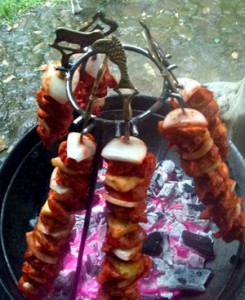
Pork loin onions and pineapple al pastor.
Tacos al pastor are the most popular around Mexico. These are made of seasoned pork meat skewered on a steel rod, exposed to a charcoal vertical roaster—today being replaced by a gas burner. As we noted in a previous post on tacos, specifically tacos al pastor, “the technique—roasting on a vertical grill—was imported from the Middle East, and the pork from Spain, but the seasoning on the meat is from the Yucatan peninsula spiced up with chiles from the north of Mexico.” The popularity of these tacos grew faster than the ability to learn how to cook them al carbón as they originally were conceived and named. This gave way to the development of a gas burner al pastor appliance. The name al pastor comes from the fact that the cooking takes place by exposing the meat vertically and rotating it in front of coals or today a gas burner.
In northern Mexico, mesquite wood is abundant and appropriate for al pastor cooking. In tropical lands, exotic woods abound but because of the climate—hot and humid—roasting on an open fire is not fun. Mangrove, however, is a good choice for roasting, if you dare—the mosquitoes will hate you— but since it comes from fragile ecosystems in Mexico, it is prohibited to harvest. Open fire cooking wood needs to come from a “natural death” tree and left at least one year to dry. Not easy.
Can you do al pastor cooking at home? You have! Ever done marshmallows, hot dogs, or bacon on a stick? That said, we are supplying you with a few recipes that will widen your al pastor repertoire! And check out the gadget (below) that I devised to convert a conventional grill into an al pastor roaster thanks to my friend Víctor Canchola who did the welding part. If you want the al pastor experience but don’t have a vertical roaster, put the meat on skewers and cook over a charcoal or gas grill, turning the skewers often. That’s always fun! Let’s continue the tradition! Enjoy!
Recipes
Cabrito al pastor
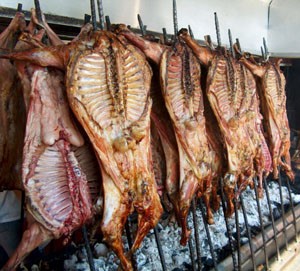
If Cabrito is not available in your area, use mutton, also a delicacy and fun to cook.
Ingredients:
2 lbs. Baby goat meat in pieces
½ Onion
2 Cloves garlic
Pinch of each: oregano, rosemary and thyme
Splash of oil
Splash of white vinegar
Salt to taste
Instructions:
Mix the onion, garlic, herbs, oil, vinegar and salt in a blender to a thick paste. Cover the meat with the rub and let it rest, covered, overnight in the refrigerator. The following day, over coals, grill the meat carefully for five minutes on each side and continue alternating sides, for between 20 and 30 minutes or until done to your liking. To prevent drying, avoid flames and have extra rub on hand. If using a standard charcoal grill, move the coals to one side and cook on the side where the heat is lower. Have fun above all!
Yield: 4 portions
Heat level: low
Tacos al Pastor
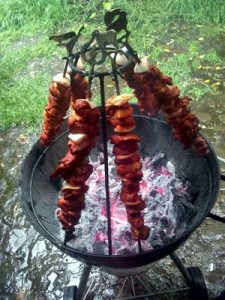
This is the perfect substitute for the popular street food tacos. Don’t be surprised if your product comes out better than the street version.
Ingredients for the adobo:
4 chiles guajillos stemmed, seeded and deveined
2 chiles de árbol stemmed, seeded and deveined (optional)
½ onion
2 cloves garlic
A pinch fine herbs
2 ounces achiote paste
4 to 6 tablespoons white vinegar
The juice of one orange
The juice of one lemon
2 tablespoons of vegetable oil
Salt to taste
Water
Ingredients for grilling:
2 lbs. pork loin in fillets marinated per above
6 fresh pineapple slices
18 corn tortillas
Fresh onions and cilantro chopped for garnish
Instructions:
Remove the stems and boil the chiles 3 to 5 minutes in two cups of water. Reserve them. Once the chiles have cooled off, puree all of the adobo ingredients in a blender into a uniform thick sauce. You may use the water wherein you boiled the chiles in the blender if you wish. Marinate the meat with the adobo for at least a couple of hours or overnight in the refrigerator.
Set up your wood or charcoal or gas grill for low heat and grill the marinated pork fillets and the whole pineapple slices. Heat the tortillas. Chop the cooked meat and pineapple and make yourself some tacos. Garnish with fresh onion and cilantro. We recommend the salsa below.
Yield: 18 tacos
Heat level: mild
Salsa Taquera
8 Tomatillos
8 Chiles morita. Substitute chipotle
4 Chiles de árbol (optional)
½ Onion
2 Garlic cloves
Salt to taste
Cooking oil
Instructions:
Roughly chop the tomatillos, chiles, onions, and garlic, and fry them in oil until the tomatillos are soft. Mix everything in a blender and add the salt to create a uniform salsa.
Yield: 2 cups
Heat level: hot
Latest posts by José C. Marmolejo (see all)
- Unconventional Seafood Salsas - 04/25/2022
- Cocineras Tradicionales: The Traditional Cooks of Mexico - 04/01/2022
- Carnitas Calientes - 03/11/2022

